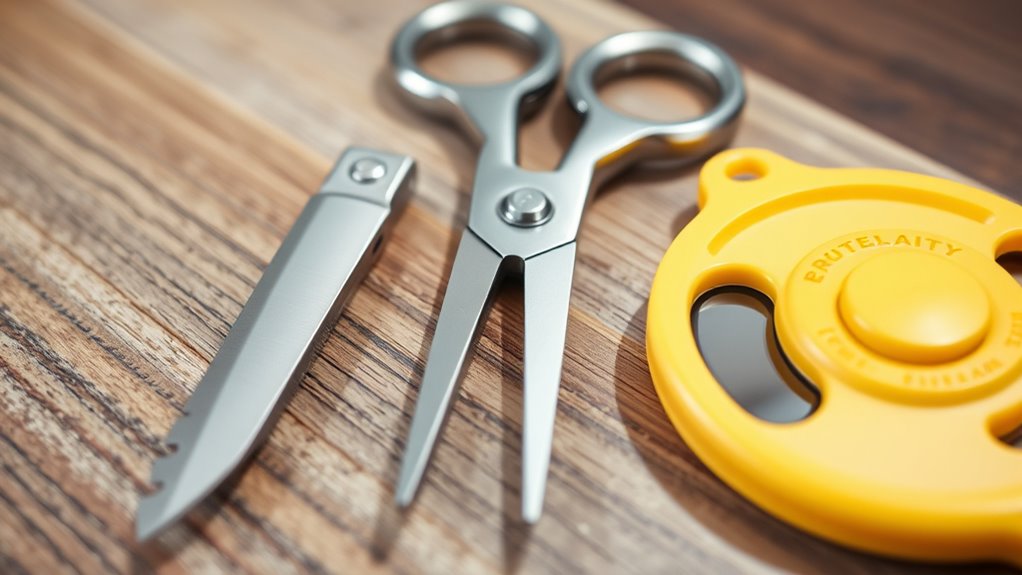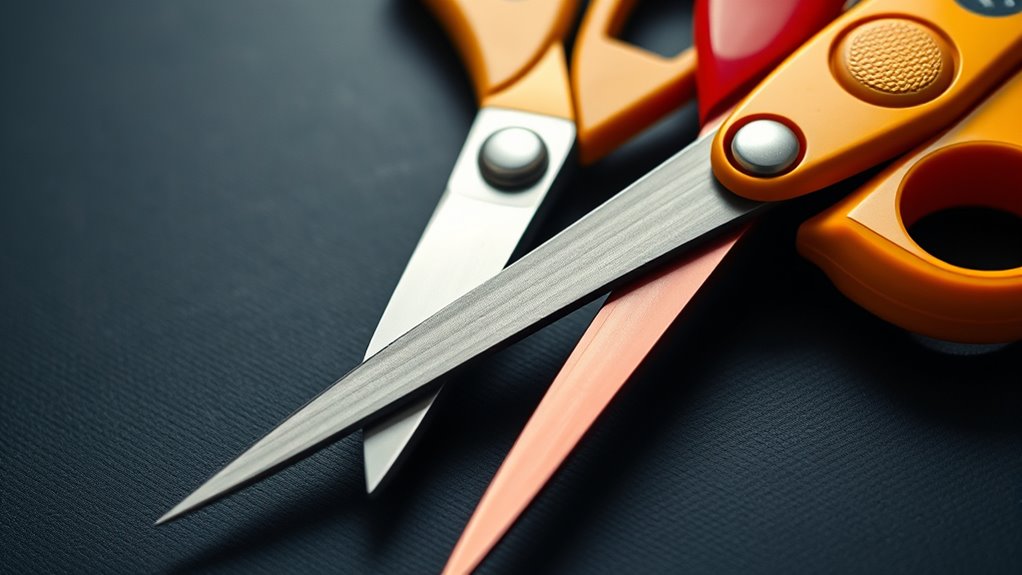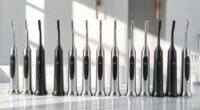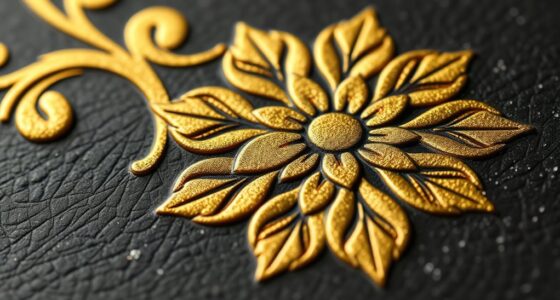To cut like a pro, choose your tool based on your project. Use a craft knife for precise, detailed cuts, especially on delicate materials. Scissors are versatile and quick for general tasks, while rotary cutters excel in making straight, clean cuts on fabrics or large surfaces. Keep in mind that high-quality, durable blades and ergonomic designs improve control and reduce fatigue, helping you achieve smoother results. To master each tool’s strengths, explore more about their features and ideal use.
Key Takeaways
- Craft knives provide precision for intricate cuts, ideal for detailed projects requiring control.
- Scissors are versatile and quick for general cuts but may lack fine detail accuracy.
- Rotary cutters excel in straight, clean cuts on large surfaces like fabric, offering durability and efficiency.
- Ergonomic features across tools reduce fatigue and improve control, enhancing professional cutting results.
- Selecting the right tool depends on project material, detail level, and need for blade durability and comfort.

Cutting tools are essential instruments used to shape, remove, or divide materials in manufacturing and machining processes. When choosing the right tool, one of the most important considerations is blade durability. You want a blade that stays sharp longer, reducing the need for frequent replacements and ensuring clean, precise cuts every time. A durable blade maintains its edge through repeated use, which not only saves you time but also minimizes frustration. Alongside durability, ergonomic design plays a crucial role in your comfort and safety. Tools designed with ergonomic principles help reduce hand fatigue and allow for better control, especially during prolonged tasks. Whether you’re slicing through fabric, paper, or thicker materials, having a comfortable grip makes a significant difference in your cutting performance.
When comparing a craft knife, scissors, and a rotary cutter, each has distinct features that cater to different needs. A craft knife offers precision, especially for detailed work or intricate cuts. Its sharp, replaceable blade allows for fine control, but you need to be cautious about blade durability—over time, the blade dulls, which can compromise cut quality. An ergonomic handle ensures you can maneuver the knife smoothly, minimizing strain on your hand. Scissors are versatile and familiar, often used for quick, straightforward cuts. Their blade durability varies depending on the quality, but high-grade scissors tend to hold their edge longer. The ergonomic design of scissors—especially those with contoured handles—helps you cut comfortably without squeezing too hard, reducing fatigue during extended use.
A rotary cutter, on the other hand, is ideal for fabric and large, straight cuts. Its circular blade spins smoothly as you roll it over your material. The blade’s durability is indispensable here, as a dull rotary cutter can cause uneven cuts or require excessive force, which can lead to accidents. High-quality rotary cutters come with blades that are both durable and easy to replace, ensuring consistent performance. Ergonomic features like a comfortable, non-slip handle and a safety guard contribute to safer, more precise cutting. When you’re working on larger projects, the ergonomic design of the rotary cutter allows you to apply steady pressure without discomfort, making your work more efficient and enjoyable. Additionally, selecting tools with blade durability ensures you maintain high performance over time and reduce the frequency of blade replacements.
Ultimately, selecting the right cutting tool depends on your specific project needs. Prioritize blades with high durability for cleaner cuts and less downtime. Equally, choose tools with ergonomic designs to enhance comfort and control. With the right combination of these features, you’ll cut confidently and accurately, whether you’re working on detailed crafts or larger fabric projects.
Frequently Asked Questions
Which Cutting Tool Is Safest for Beginners?
For beginners, scissors are the safest cutting tool because of their simple, ergonomic design, which reduces the risk of accidents. They typically have durable blades that are less prone to breaking. While craft knives and rotary cutters offer precision, they require careful handling and sharp blades that can pose safety risks. Starting with scissors helps you build confidence before moving on to more advanced tools with better blade durability.
Can Craft Knives Be Used on Fabric?
Like a master chef in a vintage kitchen, you can definitely use craft knives on fabric. Just guarantee your blade’s sharpness is up to par, as dull blades can snag delicate fabrics like silk or chiffon. Different fabric types require careful handling, but a sharp craft knife allows precise cuts for quilting or detailed projects. Always practice on scrap material first to prevent any mishaps, and you’ll be cutting like a pro in no time.
How Do Rotary Cutters Prevent Fabric Fraying?
Rotary cutters prevent fabric fraying by providing clean, precise cuts that help stabilize the fabric edge finishing. When you use sharp rotary cutter blades, they slice through fabric smoothly, reducing unraveling. Make certain to use a rotary cutting mat and a ruler for accuracy, which further minimizes fraying. Proper blade maintenance and gentle, steady pressure ensure neat edges, making your fabric less prone to fraying over time.
Are Scissors or Rotary Cutters Better for Intricate Cuts?
Like a painter with a fine brush, you’ll find scissors excel at intricate cuts thanks to their precision tips. They allow for delicate, controlled movements that rotary cutters can’t match. While rotary cutters have durable blades for straight, clean cuts, scissors give you the finesse needed for detailed work. For intricate designs, scissors are your best choice, providing the accuracy and control you need to bring your vision to life.
What’s the Ideal Storage Method for Cutting Tools?
You should store your cutting tools in a designated, secure container, like a toolbox or a dedicated drawer, to guarantee storage safety. Keep blades covered or sheathed to prevent accidental cuts and maintain blade maintenance by cleaning and oiling them regularly. Avoid leaving them loose in drawers to prevent dulling or damage. Proper storage keeps your tools sharp, safe, and ready for precise cuts whenever you need them.
Conclusion
No matter which cutting tool you choose—craft knife, scissors, or rotary cutter—knowing their strengths helps you work smarter. Did you know that rotary cutters can slice through up to 10 sheets of paper at once, saving you time? Mastering each tool guarantees cleaner cuts and safer handling. So next time you’re tackling a project, pick the right tool for the job — and cut like a pro!









